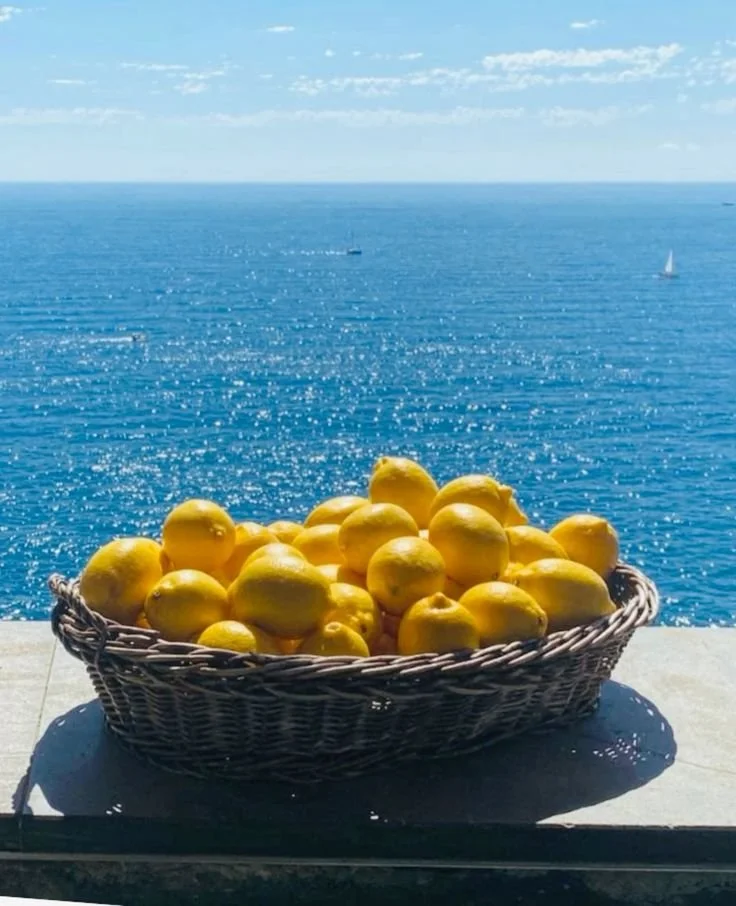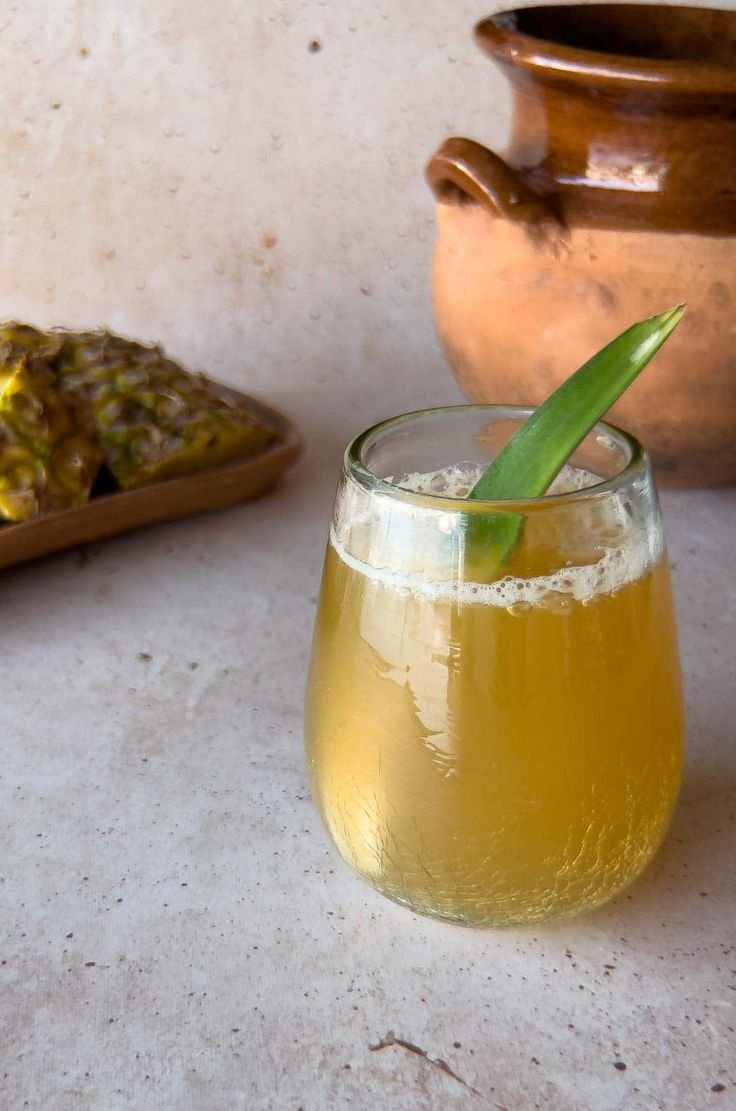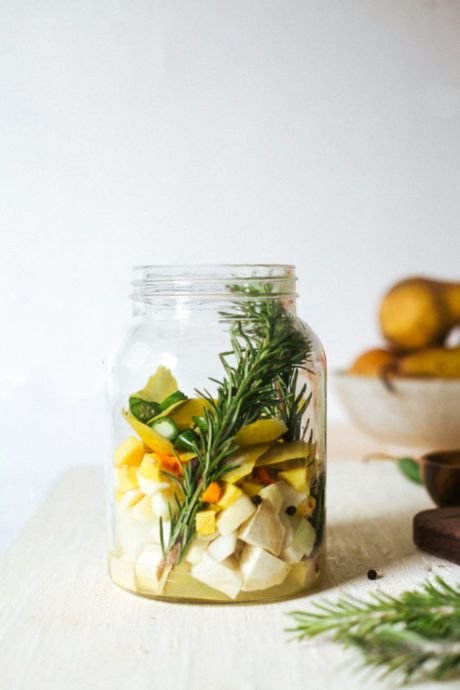The Living Pantry: A Year of Ferments, Cultures & God-Given Foods
Not everything in a kitchen comes from a packet or a plan.
Some things live quietly in a jar at the back of the counter. A crock murmuring under cloth. A starter rising and falling like the tide. Others fizz and settle on the windowsill, warm with life.
These are the slow, living staples — the ones you stir with your hands, feed like a pet, or pass down.
This pantry isn’t just stocked. It’s alive. Bubbling, breathing, quietly working in the background — adding depth to soups, tang to sauces, softness to bread, and something almost holy to a warm bowl of rice.
There is no rush here. Just the pace of seasons, the patience of microbes, and the gift of time. They ask for a little care and give back more than we expect.
They hum through the seasons, transforming what’s raw into what heals: microbes working while we sleep, sourness turning into strength.
We don’t need a full lab or endless time. Just a clean jar. A wooden spoon. Salt, water, sugar, maybe a dried fig — and a little trust in God’s design.
This isn’t modern. This is ancient. It’s what came before the fridge, and the barcode.
And because the year turns, this guide does too — shifting gently with the months.
From spring’s ginger bugs to autumn’s bubbling apple scraps, winter’s kefir to summer’s wild ferments, this is a pantry shaped by the weather, the garden, and your body’s cravings.
It’s not about doing it all. It’s about doing what fits your season — the literal one, and the one you’re living in.
Here’s how we keep a shelf of living foods across the year: slow, sour, sweet, and sustaining. From one season to the next, by God’s design.
spring
Photo: We always aim to credit photos; if this one needs crediting or removal, please contact us with the source.
SPRING
Winter always starts with charm — a chance to slow, to stew, to light candles in the quiet. But somewhere near the end, when your skin aches for sunlight and you’ve grown tired of folding yourself into wool, the days feel like held breath. And then — spring.
The light changes first. Not just brighter, but warmer. Real. You feel it on your forearms as you crack open the window and let the house inhale again. The scent of something green. The hum of children spilling back outdoors, jackets forgotten. The clink of a jar placed by the windowsill, where the sun now lingers long enough to coax it awake.
You start letting dough rise on the garden table instead of in the oven with the light on. A ginger bug stirred every morning — just ginger, sugar, and water — bubbling into the base for homemade sodas, fizzy enough to delight even skeptical little ones. A jar of honey-fermented garlic, made with just the right warmth to coax out the slow, golden medicine inside. Fresh herbs are snipped again — chive, parsley, dill — stirred into soft cheeses or folded into kefir dressings.
There’s a flow here that feels almost biblical — cycles of waiting, of preparing, of watching things rise from what looked like nothing. The same patience that once preserved grapes into wine and milk into cheese still lives in these old, slow ways.
You don’t need to do it all. Just pick one. One jar. One bowl. Leave it out. See what happens.
What You’ll Need
Start small. These are the handful of things that carry spring’s spirit — brightness, renewal, and a soft return to warmth.
Essentials
• Clean glass jars — wide-mouthed if you can, for easier stirring
• Unrefined cane sugar or raw honey
• Fresh ginger root
• Garlic heads — firm, not sprouting
• Unchlorinated water — filtered or left out overnight
• Sea salt — fine or flaky, not iodized
• Whole grains — rye flour, spelt, or strong white flour for sourdough
• Fresh herbs — chives, dill, parsley — a few pots on the windowsill work beautifully
• A linen cloth or coffee filter and rubber bands for covering jars
• A wooden spoon for daily stirring
Optional, but beautiful
• A sunny windowsill or outdoor corner with a touch of heat
• Lemon peel, for uplifting notes in ferments
• Whole peppercorns or pink pepper for spice-bright infusions
• A little kefir culture, if you’re ready to begin the rhythm of daily milk, yogurt, or fuzzy drink
These are not complicated things. Most were in a grandmother’s pantry long before fermentation was fashionable. God’s design is like that — low-tech, high reward.
GINGER BUG
A few slices of fresh ginger, a spoonful of sugar, and a jar of water — stirred daily and left to catch the light. Within days, it bubbles. Alive.
This is your homemade wild soda starter, the base for springtime drinks: rhubarb fizz, fermented lemonade, even a strawberry shrub when the fruit turns soft too fast.
→ Why spring: Warmer air helps it wake up quickly, and the body craves something zingy after months of heaviness. Ginger also supports circulation and digestion — a gentle nudge after winter’s stillness.
How to:
Use a clean glass jar. Combine 2 tbsp grated or sliced unpeeled ginger, 2 tbsp sugar (organic if you have it), and 2 cups filtered water. Stir well. Cover loosely with cloth and a rubber band.
Each day, stir and feed with 1 tsp ginger + 1 tsp sugar. Within 3–5 days it should begin to bubble.
Care: Keep on the counter, out of direct hot sun but where warmth can find it.
To use: Strain and add to sweetened fruit juice for a wild fermented soda, or use ¼ cup to inoculate a full batch of herbal ginger ale.
Wild Garlic Ferment
Wild garlic appears just as spring begins. Packed into a jar with sea salt and left to soften, it becomes a punchy green paste you’ll want to smear on everything.
→ Why spring: It’s one of the first wild gifts of the year — and like manna, it doesn’t last long. Fermenting keeps it with you a little longer.
How to:
Wash and dry a bunch of wild garlic. Chop finely and mix with 2% sea salt by weight. Press into a small jar, pushing down until brine rises. Seal with lid or fermenting weight.
Care: Leave at room temp for 5–7 days, then refrigerate.
To use: Spread on toast, swirl into butter, add to salad dressings or soups. One spoon transforms everything.
Fermented Honey Garlic
Raw honey poured over fresh garlic cloves. No vinegar. No water. Just time. The honey thins, the garlic mellows. The whole thing becomes golden medicine.
→ Why spring: It supports immunity in that weird in-between season, where it’s warm one day and cold the next. Let God’s own antibiotics do their work.
How to:
Peel organic garlic cloves. Place in a small jar and cover fully with raw, unheated honey. Stir with a wooden spoon to remove air pockets.
Care: Leave at room temp, lid loosely placed, and stir daily for a week. Bubbles may form — that’s good. After a week, seal and store cool.
To use: Swallow a clove at the first sign of sniffles, drizzle the honey over roasted carrots, or stir into warm (not hot) tea.
Sourdough Starter Reawakening
If your starter’s been sleeping in the fridge all winter, now’s the time to bring it back to life. Feed it with flour and water, place it on a sunny sill, and watch the rhythm return.
→ Why spring: You can finally let it rise outdoors or on a sunlit windowsill — the light does what the oven light did in winter. There’s something beautiful in that shift.
How to:
Discard most of your cold starter, leaving about ¼ cup. Feed with equal weights of flour and water. Cover loosely and let sit in a warm place. Repeat daily for 3–5 days.
Care: Use filtered water. Don’t worry about exact timing — follow the bubbles and the rise.
To use: Once active, use to bake bread, crepes, pizza dough, or even waffles. Add a spoon to batters for extra tang and softness.
Milk Kefir (or Coconut Kefir)
Kefir is a daily rhythm more than a recipe — the grains sit in milk (or coconut milk), transform it overnight, and gift you a probiotic elixir by morning.
→ Why spring: The body is beginning to cleanse naturally. Kefir supports that — balancing the gut, clearing the skin, and softening inflammation. It’s alive, like the season.
How to:
Add 1–2 tbsp kefir grains to 2 cups milk (dairy or full-fat coconut). Cover with cloth and leave on the counter 12–24 hours until slightly tangy.
Care: Strain out the grains and repeat the next batch. Rinse grains only with milk — not water.
To use: Drink cold, add to smoothies, or use in overnight oats or spring cakes.
Pickled Spring Vegetables
Radishes. Carrots. Baby beets. Slice, salt, submerge. Add herbs or spices if you like. These quick pickles are crunchy, tangy, and gone in a flash.
→ Why spring: These vegetables are crisp and young — the perfect time to preserve their brightness. No heavy brine needed, just a gentle touch.
How to:
Thinly slice vegetables. Mix 1 cup water, ½ cup vinegar (like apple cider), 1 tbsp honey, and 1 tbsp sea salt. Pack veg into a jar and pour over brine. Add garlic or dill if desired.
Care: Let sit in the fridge 1–3 days before tasting. Will last several weeks.
To use: Add to grain bowls, sandwiches, or enjoy straight from the jar with lunch.
summer
Photo: We always aim to credit photos; if this one needs crediting or removal, please contact us with the source.
summer
By July, the windows don’t just crack open — they stay that way. Curtains billow, fruit overripens, and the days are long enough for two meals on the terrace and a third one barefoot in the kitchen. The heat carries things forward. Ferments quicken. Fruits begin to fizz on their own if you’re not careful.
This is the pantry’s most alive season — it sours fast, sweetens quicker, and doesn’t wait for anyone. You can’t control it, but you can work with it.
Leave the kombucha on the shelf too long and it’ll vinegary itself into something that’s perfect for dressings. Catch your tomatoes before they collapse and you’ll have a raw sauce that tastes like sun and soil. Even pineapple rinds become medicine here.
And then there’s the wildness — of lacto peaches and fizzy strawberries, of jars burping on the counter while your children run wet through the house, trailing pool water and summer air.
Let it be sticky. Let it be wild. Let it work for you.
What You’ll Need
Summer’s pantry is bright and barely tamed. Focus on what’s fast, fresh, and forgiving.
Essentials
• Glass jars — some flip-top for pressure ferments
• Fresh summer fruit — peaches, strawberries, plums, watermelon rind
• Unrefined sugar or raw honey
• Fresh herbs — basil, mint, thyme
• Vinegar — raw apple cider or white wine
• Sea salt
• Lemon peels or citrus zest
• Black or green tea — for kombucha
• Water kefir grains
• Pineapple cores or rinds
• Whole mustard seeds, peppercorns, or fennel seeds
Optional, but delightful
• Cloth covers and flip-lids
• Mesh strainer
• Old swing-top bottles for bottling drinks
• A corner that stays a little cooler than the rest — for slow ferments
These aren’t fussy projects. They’re seasonal ones — a way to catch the fullness before it turns.
Fermented Strawberry Soda
Strawberries ferment quickly in summer — too quickly if left alone. But when stirred with sugar and water, they become a tangy, fizzy soda that tastes like childhood and stained fingers.
→ Why summer: Fermentation is fast and forgiving in this heat. Strawberries are abundant and spoil-prone — this turns softness into sparkle.
How to:
Slice 2 cups strawberries and mix with ½ cup sugar and 4 cups water. Add a spoonful of ginger bug or water kefir if you have it. Cover with cloth and stir twice a day.
Care: Ferment 2–3 days until slightly bubbly, then strain and bottle. Chill before drinking.
To use: Drink cold on the terrace or pour over ice with mint. Add a dash of lime for brightness.
Kombucha (Quick Summer Brew)
If you’ve got a SCOBY, summer is its season. Fermentation accelerates in the heat — what takes a week in winter might take just 3 days now.
→ Why summer: Kombucha thrives in heat. It becomes tart and crisp fast, perfect for sipping or using as a vinegar alternative.
How to:
Brew 4 bags black tea in 1L hot water. Add ¼ cup sugar. Cool fully. Add your SCOBY and ½ cup mature kombucha.
Care: Cover with cloth and ferment 3–5 days depending on your taste. Bottle with fruit or herbs if desired.
To use: Drink straight, dilute with sparkling water, or use the vinegary versions as salad dressing or quick pickle brine.
Fermented Peach Preserves
Overripe peaches can go soft in hours. But with a little salt and patience, they melt into a tangy, spoonable preserve.
→ Why summer: This is peak stone fruit season — and they’re best caught right before collapse. A pinch of salt saves their sweetness.
How to:
Chop peaches (skins on), mash slightly, and add 1 tsp sea salt per cup. Add a few basil leaves or lemon zest. Press into a jar until juices rise.
Care: Leave loosely covered at room temp 2–3 days, then refrigerate.
To use: Spoon onto yogurt, serve with grilled meats, or swirl into kefir.
Lacto-Fermented Tomato Salsa
Chop, salt, wait. That’s it. Summer tomatoes do the rest. Add a chili or garlic if you like heat.
→ Why summer: Tomatoes are bursting with juice — and ferment into the most addictive spoonable sauce in just a day or two.
How to:
Chop 2 cups ripe tomatoes. Add 1 tsp sea salt, a clove garlic (optional), and chili or onion to taste. Press into jar, cover loosely.
Care: Ferment 1–2 days max in the heat.
To use: Eat cold with bread, fish, or grilled vegetables. Freezes beautifully too.
Pineapple Tepache
Made from scraps — skins and cores — tepache is summer’s most forgiving drink. Sweet, slightly tangy, and naturally effervescent.
→ Why summer: Pineapples are ripe, cheap, and everywhere. Their skin carries the yeast — the heat does the rest.
How to:
Place roughly chopped pineapple peels and core in a jar. Add ¼ cup sugar per pineapple and enough water to cover. Add a cinnamon stick if you like.
Care: Cover with cloth and ferment 2–3 days. Strain and bottle.
To use: Serve over ice, or let fizz a day longer in the bottle for extra tang.
Quick Summer Pickles
Cucumber, zucchini, green beans. Anything fresh and crisp can be pickled quickly for tangy snacks and easy lunches.
→ Why summer: Summer veg are tender and don’t need a long soak. Herbs like dill and mustard seeds add a fragrant touch.
How to:
Slice veg, cover with brine (1 cup water, ½ cup vinegar, 1 tbsp salt, 1 tsp sugar). Add herbs or garlic if desired.
Care: Chill after 1–2 days.
To use: Add to picnic spreads, tuck into sandwiches, or snack straight from the jar.
Fall
Photo: We always aim to credit photos; if this one needs crediting or removal, please contact us with the source.
fall
Summer doesn’t end abruptly. It exhales. The stone fruit bruises. The sea stays warm, but the air begins to thin. Sandals linger by the door longer than they should, but one morning the chill reaches your ankles and you know: it’s time.
This season smells of woodsmoke, baked apples, and soil still damp from early rain. Leaves curl, colors deepen, and your kitchen follows suit. Ferments thicken. The bubbles slow. Sourdough turns heartier, kefir gets richer, and everything starts to taste more… grounded.
You bring jars in from the sill and tuck them somewhere darker. Cover your starter like a blanket. Let things rest longer, rise slower, sour deeper.
In fall, we lean into warmth — not fire-hot, but the kind that comes from a jar of spiced kraut or a spoonful of honey vinegar. These ferments are less about lightness now, more about depth. The way Jesus often withdrew to quiet places — fall asks the same. Stillness. Contemplation. Letting the inner work begin.
What You’ll Need
Fall’s pantry is about deep nourishment. Slowness. Tangy sweetness. Spice and strength.
Essentials
• Apples — fresh or bruised — the older, the better
• Cabbage — green, red, or napa
• Carrots and beets
• Raw apple cider vinegar with the mother
• Raw honey
• Sea salt — unrefined, non-iodized
• Garlic, ginger, turmeric root
• Whole spices: mustard seeds, fennel, bay leaves, peppercorns
• Glass jars, weights or small fermentation lids
• Sourdough starter, or flour to begin one
• Filtered or dechlorinated water
Optional but divine
• Horseradish root — for immune-boosting ferments
• Dried chili — for heat
• Cinnamon sticks, cloves, star anise — for apple-based brews
• Fresh herbs like thyme or rosemary
• A dark cabinet or shelf for longer ferments
These are the ingredients of warmth — not just in food, but in the body. Preserved, fermented, and shared, they carry us inward as the light grows gold.
Spiced Apple Scrap Vinegar
Peels, cores, a spoonful of honey, and time. Apple vinegar is the kind of kitchen alchemy that reminds you God wastes nothing.
→ Why fall: Apples are abundant. The peelings from pies, cakes, or snacks become a new creation. A slow, tangy, healing vinegar for dressings, sipping, or even skin.
How to:
Fill a clean jar ¾ full with organic apple scraps. Add 1–2 tablespoons raw honey and fill with filtered water, leaving space at the top. Cover with cloth and a rubber band.
Care: Stir daily for the first week, then leave in a dark place for 3–4 weeks. Strain and bottle when tangy.
To use: Mix into salad dressings, herbal shrubs, or drink a splash with warm water in the morning.
Golden Kraut (Cabbage + Turmeric + Ginger)
Chopped cabbage, grated turmeric and ginger, and sea salt. Pressed down and left to brine in its own juices, this becomes a gut-healing, immune-loving kraut full of sunshine.
→ Why fall: As colds creep in and the air dries out, turmeric and ginger offer anti-inflammatory, warming support — fermented into something the body can truly receive.
How to:
Shred 1 small cabbage. Add 1 tbsp grated turmeric, 1 tbsp ginger, and 1 tbsp sea salt. Massage until brine forms. Pack into a jar and press down well.
Care: Ferment on the counter for 5–10 days. Use a weight if needed to keep submerged.
To use: Spoon onto warm bowls, tuck into wraps, or pair with roasted squash.
Honey-Fermented Horseradish
This one’s sharp, bold, and unforgettable. Fresh horseradish root grated and tucked into honey. It stings — in the best way.
→ Why fall: Horseradish clears the sinuses and stirs sluggish systems — like a trumpet blast for your immune cells. Fermented in honey, it becomes fire turned medicine.
How to:
Grate horseradish and add to a small jar. Cover fully with raw honey. Stir to remove bubbles.
Care: Stir daily for 5–7 days, then cap and keep in a cool dark place.
To use: Mix into mustard, add to vinaigrettes, or take a small spoonful at the first sign of congestion.
Sourdough Pumpkin Flatbread
A spoonful of starter, some mashed pumpkin or squash, a bit of flour and oil — pan-fried until golden. Not quite bread, not quite pancake. Just right.
→ Why fall: Squash is plentiful, your starter still active, and warm food cooked quickly becomes your daily routine.
How to:
Mix ½ cup sourdough starter, ⅓ cup mashed roasted squash, ½ cup flour, 1 tbsp olive oil, pinch of salt. Let sit 2–4 hrs.
Care: Cook on a skillet, medium heat, until golden and cooked through.
To use: Serve warm with herbed yogurt or kraut.
Fire Cider (Fermented Tonic)
A fiery tonic of apple cider vinegar steeped with garlic, onion, horseradish, ginger, turmeric, chili, and citrus peel. A classic herbal ferment — bold and biblical in spirit.
→ Why fall: A tried-and-true immunity booster, traditionally made in the fall to be ready for winter’s first strike.
How to:
Layer chopped onion, garlic, horseradish, ginger, turmeric, lemon peel, and chili into a jar. Cover with raw ACV. Shake well.
Care: Steep 3–4 weeks in a cool dark place. Shake occasionally. Strain and store.
To use: Take a spoonful daily or add to salad dressings and marinades.
Winter
Photo: We always aim to credit photos; if this one needs crediting or removal, please contact us with the source.
winter
Winter arrives not with loudness, but with weight. A hush that settles over the house like snow on stone. Time thickens, light thins, the garden rests, and the air carries the scent of cold.
And yet, something stirs inside — a craving not for freshness, but for warmth that roots deep. For broths that coat the throat, for drinks that hum with spice, for jars that murmur quietly behind cupboard doors. This is the season of what simmers. What strengthens. What waits.
It’s when the starter slows, the kombucha darkens, the kefir turns creamier. And you slow with it. Steeping, sipping, wrapping sourdough in linen like a swaddled child.
These ferments aren’t flashy. They’re steady. The kind that remind you God works in stillness too — the kind that nourish marrow, not just appetite. This is how we ferment in the dark: with trust, patience, and something warm between our hands.
What You’ll Need
Winter asks for fewer ingredients, but deeper ones. Think mineral-rich, deeply spiced, and slow to change — like the season itself.
Essentials
• Cabbage — for sauerkraut or kimchi
• Garlic, onion, and leeks
• Ginger and turmeric root
• Raw honey
• Whole spices: cloves, cinnamon, cardamom, star anise
• Strong black tea — for kombucha
• Raw apple cider vinegar
• Sourdough starter
• Organic milk or full-fat coconut milk — for kefir
• Root vegetables: carrots, turnips, daikon
• Filtered water
• Sea salt — fine, unrefined
• Cloths and fermentation jars
Optional but warming
• Dried figs or dates — for deep, fruit-sweet infusions
• Bay leaves, dried rose petals, or orange peel
• A dark cabinet or pantry corner
• A quiet hour and a heavy pot
Cinnamon-Spiced Sauerkraut
Cabbage shredded fine, massaged with sea salt, touched with clove and cinnamon. Not quite sweet, not quite savory — just warm.
→ Why winter: Cabbage stores well, and this ferment keeps it alive even longer. The warming spices are antimicrobial and comforting — God’s built-in medicine for cold days.
How to:
Shred 1 head cabbage. Add 1 tbsp sea salt, ½ tsp cinnamon, a pinch of clove. Massage until it releases brine. Pack into a jar, weigh down.
Care: Ferment 1–2 weeks in a cool space. Refrigerate when tangy.
To use: Serve with roasted meats or spoon over creamy lentils.
Root Kimchi
Turnips, carrots, daikon — chopped into batons and bathed in brine, then spiced with garlic, ginger, and a touch of chili. Funky, fiery, fantastic.
→ Why winter: Roots hold the last of the earth’s strength. Kimchi activates the gut, warms the belly, and strengthens the immune system in the coldest months.
How to:
Soak chopped roots in saltwater for 3–4 hours. Drain. Blend garlic, ginger, and chili flakes into a paste. Mix everything together and pack into a jar.
Care: Ferment 3–5 days at room temp, then refrigerate.
To use: Serve with rice, eggs, or wrap in a warm flatbread with herbs.
Fermented Garlic Honey (Winter Batch)
Same as spring’s, but deeper now. Add star anise, clove, or even black pepper to make this a multi-layered tonic.
→ Why winter: Garlic is most potent raw — and honey helps it go down. A spoonful before bed wards off more than just cold.
How to:
Peel garlic and cover with raw honey, adding a few whole spices. Stir well to release bubbles.
Care: Keep loosely lidded for a week, then seal. Store in a cool dark place.
To use: Swallow a clove at first sign of illness, stir honey into ginger tea, or drizzle over roasted veg.
Black Tea Kombucha
Dark. Bold. A touch of sourness. This isn’t the bright fizzy summer drink — this is kombucha brewed slow and strong.
→ Why winter: Black tea carries warmth and tannins that feel grounding. A slightly longer ferment gives more depth, more acids, more bite.
How to:
Brew 4 cups black tea, sweeten with ½ cup sugar, let cool. Add SCOBY and starter kombucha. Cover and leave for 10–14 days.
Care: Store in a warm-ish place (but not hot). Taste every few days.
To use: Drink as-is, or mix with spiced juice for a homemade winter soda.
Sourdough Rye Loaf
Heavier. Earthier. A slower rise, but richer result. This is the kind of bread you slice thick and eat with your hands still warm from the oven.
→ Why winter: The cold slows fermentation — but rye flour supports a deep, satisfying ferment that keeps bellies full and bodies strong.
How to:
Mix 1 cup sourdough starter with 1½ cups rye flour, 1 cup water, 1 tsp salt. Let rise 8–12 hours. Shape and bake at 220°C (425°F) for ~35–45 min.
Care: Cover with cloth while rising to keep in warmth.
To use: Slather with cultured butter, or eat plain with soup and pickles.
These jars, these crocks, these slow and bubbling bowls — they’re not trends or tasks. They’re a remembering of a time before fridges hummed and shelves were lined with barcodes, of mothers who stirred with their hands and grandmothers who knew the weather by the feel of the dough, and of biblical meals — unleavened, fermented, alive — designed not just to feed, but to heal, to sustain.
The living pantry is not about doing it all, but rather about listening to the season, to your body, and to what God may be calling you to prepare — not just for health, but for natural flow of times and surroundings.
It is one of the simplest ways to live closely with His creation. To take what He’s given — grain, salt, water, sun — and let it become something more. Through time and trust.
Spring brings brightness and fizz, a rising again.
Summer calls for wildness — sticky jars and sweet syrups fermented under heat.
Autumn is for abundance, for preserving, for catching the last ripeness before it fades.
And winter — winter is for depth. For slow strength. For stillness and spice.
Each turn of the year offers a new note to sing.
Start with one jar. One corner of your kitchen that feels a little warmer, a little slower. Let the seasons teach you. Let the ferments fizz, hum, and buzz in the background of your days. Let your children remember the smell of sourdough rising and the clink of honeyed garlic in glass.
And in time, your pantry will not just feed you.
It will speak — of tradition, of wisdom, of God’s design still alive in the smallest, simplest things.
Related Reads You’ll Love















A season-by-season, step-by-step guide to fermenting, preserving, and reviving living foods at home — from sourdough and kefir to pickles, ginger bug, and wild herbal ferments. Ancient rhythms, biblical wisdom, and practical how-tos for your living pantry.